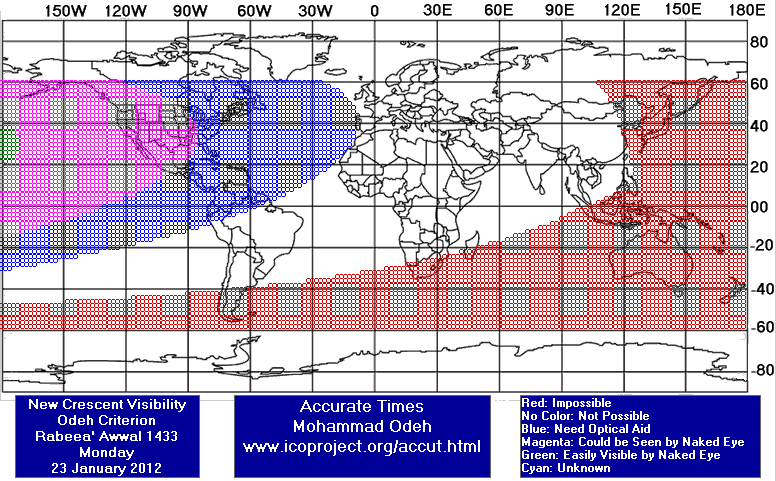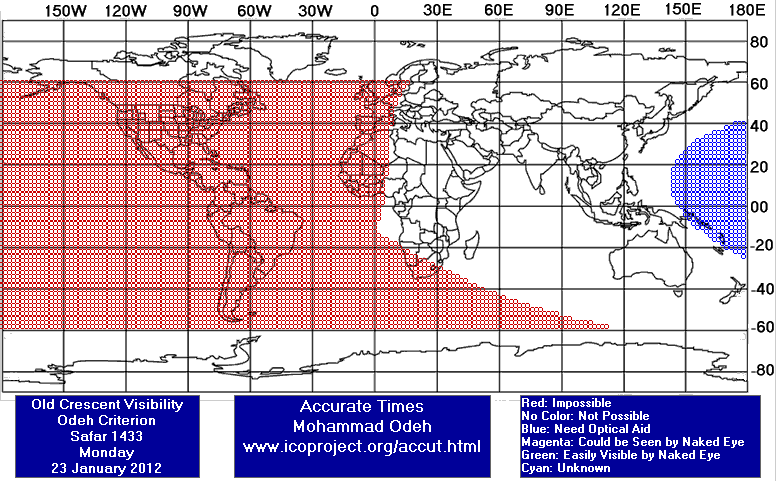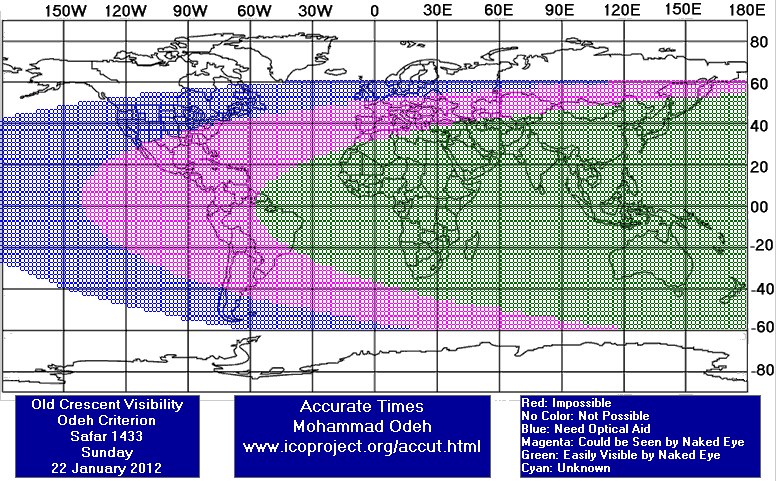Visibility of Rabee' Al-Awwal Crescent 1433 AH
- When to Observe Rabee' Al-Awwal Waxing (NEW) Crescent ?
- Rabee' Al-Awwal Waxing (NEW) Crescent Observation Results
- The OFFICIAL First Day in Different Countries
- When to Observe Safar Waning (OLD) Crescent ?
- Safar Waning (OLD) Crescent Observation Results
When to Observe Rabee' Al-Awwal Waxing (NEW) Crescent ?
The geocentric conjunction (Geocentric New Moon) will occur Inshalla on (Monday 23 January 2012) at 07:39 UT.
Sighting the new crescent on (Monday 23 January 2012) and (Tuesday 24 January 2012) is shown in the below graphs using the program Accurate Times by Mohammad Odeh according to Odeh criterion. Where:-
- It is impossible to see the crescent from the areas located under the red color. Because either the Moon on this day sets before the Sunset and/or the topocentric conjunction occurs after the Sunset.
- The crescent is expected to be seen by optical aid only from the areas located under the blue color.
- The crescent is expected to be seen by optical aid from the areas located under the magenta color. In these areas the crescent could be seen by naked eye if the atmospheric conditions are superb and the observer is experienced.
- The crescent is expected to be easily visible by naked eye from the areas located under the green color.
- The crescent cannot be seen from uncolored areas, even though the Moon sets in these locations after the Sunset and the topocentric conjunction occurs before the Sunset, but the Moon is not sufficiently illuminated in order to be seen as crescent even by optical aid.
- Kindly notice that the below graph shows the possibility of seeing the crescent from areas between 60 degrees north of Equator down to 60 degrees south of Equator.


According to the Universal Hejric Calendar (UHC), which is based on the calculated crescent visibility, the start of this month in the Eastern Region will be on Tuesday 24 January 2012 and in the Western Region will be on Tuesday 24 January 2012. Kindly notice that the UHC is a pre-calculated calendar, which adopts a certain criterion to start the new Hejric month. Your country/organization might adopt different criterion to start the new Hejric month. So it is highly advised to read the UHC website before giving any judgment.
- Results of seeing the crescent, and the first day of the month in different countries will be added here Inshalla as we receive the reports from ICOP's members. If you wish to be a member in ICOP, or to know more about it, kindly click here.
Rabee' Al-Awwal Waxing (NEW) Crescent Observation Results
Mon 23 January 2012
Algeria
Mr. Z.Abd Elouahed Delih said: "essalam alaykum i tried to sight the moon the sky was partly cloudy but i saw the sunset clearly at 17:54:40 behind far montains i measured the montains altitude by my own astrolabe it was 0.5° altitude, after 2 minutes i heared maghrib azzan i continued observing for 7 minutes then i want to pray after that i returned to home and observed the western horison until 18:35 without seeing hilal"
Ghana
Mr. Abdul-Aziz Anyang said: "The sky was clear as a star was clearly noticed after the sun had set. There was no new crescent to be seen as moon age was also less than eleven hours (11 hrs) after our sunset time in Ghana."
Nigeria
Oman
Prof. Mohammed Al-Bussaidi said: "It was cloudy in the western horizon, windy and dusty. The crescent was not seen."
Trinidad and Tobago
United Kingdom
Eng. Qamar Uddin said: "On Monday, 23 January 2012 (29 Safar 1433 AH) many people from throughout UK have attempted to sight the crescent moon (Hilal) of Rabiul Awwal after sunset. None of the groups were able to sight the Hilal, as most places were cloudy. We have not received any reliable sighting reports (Muhaqaq-Ruyat-Basari) from any countries east of UK/Morocco either. But, we have received negative sighting report from Morocco Awqaf Ministry. Therefore, the Wifaq/Batley Ulama have decided that the month of Safar 1433 AH will completed 30 days and the month of Rabiul Awwal 1433 AH will start from Wednesday, 25 January 2012, Insha-Allah."
United States
Dr. Javad Torabinejad said: "I arrived at my sighting location at 5:30 pm EST (sunset: 5:35 pm) and started scanning the partly cloudy WSW horizon, using a pair of binoculars (10X50). I stayed there till 6:15 pm (moonset: 6:20 pm)."
Tue 24 January 2012
Algeria
Mr. Hocine Chikh Aissa said: "10 observers were present in AMMI SAID institute. The new crescent of Rabee Awwal 1433 was seen by naked eyes."
Bangladesh
Indonesia
Mr. AR Sugeng Riyadi said: "On the second day after conjunction (Tuesday) January 24, 2012 The New crescent of Rabiul Awal 1433 AH was NOT SEEN from Asssalaam Observatory Surakarta Central Java Indonesia. The sky was cloudy. We are all members of CASA (Assalaam Students Astronomy Club) and students from SHS Al-Islam 1 Surakarta about 50 persons. The first of Rabiul Awal 1433 AH will be start on Wednesday, January 25, 2012 according to the goverment calendar."
Iran
Mr. Alireza Mehrani said: "Location: Esfahan, Iran Latitude: 32° 35' 27.69" N Longitude: 51° 38' 10.88" E Elevation: 2081 meters from sea level Time zone: +3.5 Observer & photographer: Alireza Mehrani Date: Tuesday January 24, 2012 (Bahman 4, 1390) Temperature: 4C° (39.2 F°) Wind: Calm Humidity: 25% Barometer: 842.0 mb Visibility: 15 km Topocentric and local time values from "Moon Calculator" (Refrac off): File: amehrani Jan 24, 2012 new1.jpg Time: 18:08 LT (14:38 UT) Moon Alt: 6° 53' 39" Sun Alt: - (8° 43' 42") Elongation: 15° 37' 35" Rel Azi: - (0° 21' 28") Moon Width: 0.57' Moon Phase: 2.08% Moon Age: 30h 58m after conjunction File: amehrani Jan 24, 2012 new2.jpg Time: 18:18 LT (14:48 UT) Moon Alt: 4° 57' 32" "
Malaysia
Mr. Firdaus Mazlan said: "On Tuesday, 24th January 2012 M equal to 29 Safar 1433 H, my friend (Mohd Saiful bin Saidi, Mohd Redzuan bin Pandil, Muhammad Afiq bin Mohd. Safri) from Kuala Kedah, Kedah (06:06:0.6289 N , 100:17:22.0585 E) has seen the new moon with naked eye at 7.44 pm. I with my friend (Mr. Nik Mohd Ridzuan bin Shaharuddin, Mr. Mohd Asrol bin A. Bakar, Mr. Lokman, Mr. Mohammad Haniff bin Md Yusoff, Mr. Asmanizam, Mr. Mohd Azrai, Mr. Muhammad Zainal Abidin bin Mohamad Hani, Mr. Azhar, Mr. Muinuddin, Mr. Muhammad Ibrahim bin Jamil, Mr. Azizi) cannot see the new moon either with telescope or with naked eye at Baitul Hilal, Teluk Kemang, Negeri Sembilan, Malaysia (02:26:43.0 N , 101:51:16.0 E). It because the horizon is very cloudy. So, tomorrow, 25th January 2012 M (Wednesday) is 1st Rabi-al-Awwal 1433 H. "
Nigeria
Dr. Usman El-Nafaty said: "I in the company of three, saw the cresent after Maghrib prayers here in Bauchi Nigeria at around 18:45. Though the sky was partially cloudy, the crescent was easily visible. I also received reports from other locations that it was sighted."
Pakistan
Mr. Alam Sultan said: "Alhamdolillah, today (Tuesday 24 January 2012= 29 Safar 1433 in Pakistan), On my request, nearly 200 persons (members of the moon-sighting committees of our institute "JAMIA-TUR-RASHEED" + my friends + their companions) easily sighted the moon at more than 10 places in 3 provinces (Balochistan, Punjab and Khebar-pakhtoon-khwa). As it was fully cloudy or rainy in province Sindh therefore I could not sight it in Karachi and there is no positive report from any part of province Sindh. Note 1: Chairman of central official moon sighting committee of Pakistan mufti munee-bur-Rahman told me on my mobile phone that as he also received positive reports therefore he announced officially that Wednesday 25 January 2012 is 1st Rabee-ul-Awwal 1433 in Pakistan. Safar month finished on 29th day. Note2 : After some days, inshaallah, a detailed report of this observation in Urdu will be available at www.esnips.com/web/moonnewsofjamiaturrasheed "
South Africa
Dr. Abdurrazak Ebrahim said: "Confirmed positive sighting in the northern areas of South Africa. The crescent was not seen in Cape Town although atmospheric conditions were fairly good."
United Kingdom
Eng. Qamar Uddin said: "Most of the UK was totally cloudy and raining today, so we did not receive any sighting report of 32 hrs old moon (alt=14 deg), which should have been easily sighted if the weather was clear."
United States
Dr. Javad Torabinejad said: "The first naked eye sighting was at 5:40 pm EST (Sunset: 5:35 pm). The western horizon was partly cloudy. The horns were at 3:30 and 8:00 O'clock (3:30;5:00;8:00)."
The OFFICIAL First Day in Different Countries
Tue 24 January 2012
1 . Algeria
2 . Bahrain
3 . Egypt
4 . Jordan
5 . Kuwait
6 . Nigeria
7 . Qatar
8 . Saudi Arabia
9 . United Arab Emirates
Wed 25 January 2012
1 . Bangladesh
2 . Ghana
3 . Indonesia
4 . Iran
5 . Malaysia
6 . Morocco
7 . Oman
8 . Pakistan
9 . South Africa
10 . United Kingdom
When to Observe Safar Waning (OLD) Crescent ?
The geocentric conjunction (Geocentric New Moon) will occur Inshalla on (Monday 23 January 2012) at 07:39 UT.
Sighting the OLD crescent on (Monday 23 January 2012) and on (Sunday 22 January 2012) is shown in the below graphs using the program Accurate Times by Mohammad Odeh according to Odeh criterion. Where:-
- It is impossible to see the OLD crescent from the areas located under the red color. Because either the Moon on this day rises after the Sunrise and/or the topocentric conjunction occurs before the Sunrise.
- The crescent is expected to be seen by optical aid only from the areas located under the blue color.
- The crescent is expected to be seen by optical aid from the areas located under the magenta color.. In these areas the crescent could be seen by naked eye if the atmospheric conditions are superb and the observer is experienced.
- The crescent is expected to be easily visible by naked eye from the areas located under the green color.
- The crescent cannot be seen from uncolored areas, even though the Moon rises in these locations before the Sunrise and the topocentric conjunction occurs after the Sunrise, but the Moon is not sufficiently illuminated in order to be seen as crescent even by optical aid.
- Kindly notice that the below graph shows the possibility of seeing the crescent from areas between 60 degrees north of Equator down to 60 degrees south of Equator.


Safar Waning (OLD) Crescent Observation Results
Sun 22 January 2012
Algeria
Mr. Z.Abd Elouahed Delih said: " essalam alaykum all > > observer: Abdelouahed Delih > cite of observation : Barika Algeria > lat: 35� 23 11.6 north > lon: 5� 22 43.7 east > > in the day of sunday 01/22/2012 i've seen the creascent for 15 minutes in my home from 07:16 to 07:31 at this time i measured the moon altitude by my own astrolabe: al=7.5� and azimuth was 120� by the same instreament. > end of view 07:31 > the following results are from odeh AT > elongation: 13� 31.5' > moon alt:07� 49' > moon az:120� 22' > sun moon relative alt:10�49.5' > ellumination:1.39%."
Germany
Eng. Martin Elsaesser said: "The weather has been bad for days and observation before sunrise was impossible. After sunset the clouds got thinner and fast moving gaps of blue sky appeared. I setup a simple goto telescope, aligned with the sun (carefull here!) and then went to the position of the crescent. I tried for a few minutes to spot the crescent visually in the gaps, but did not succeed. So, i attached the camera and in the next gap could spot the crescent in the contrast-enhanced live-stream. Soon, the clouds closed again and that was it for the day."
Iran
Mr. Alireza Mehrani said: "Location: Esfahan, Iran Latitude: 32° 38' 41.47" N Longitude: 51° 39' 54.50" E Elevation: 1572 meters from sea level Time zone: +3.5 Observer & photographer: Alireza Mehrani Date: Sunday January 22, 2012 (Bahman 2, 1390) Temperature: -8.8 C° (16.2 F°) Wind: Calm Humidity: 76% Barometer: 842.9 mb Visibility: 15 km Topocentric and local time values from "Moon Calculator" (Refrac off): File: amehrani Jan 22, 2012 old1.jpg Time: 06:27 LT (02:57 UT) Moon Alt: 3° 44' 46" Sun Alt: - (8° 04' 23") Elongation: 14° 35' 00" Rel Azi: 8° 33' 52" Moon Width: 0.51' Moon Phase: 1.80% Moon Age: 28h 43m before conjunction File: amehrani Jan 22, 2012 old2.jpg Time: 06:40 LT (03:10 UT) Moon Alt: 6° 05' 35" "
United Kingdom
Eng. Qamar Uddin said: "The eastern horizon was totally cloudy before sunrise this morning, so the waning crescent of Safar 1433 was not seen from York, UK."





